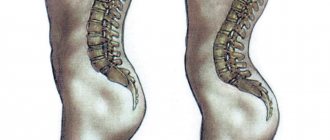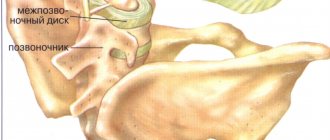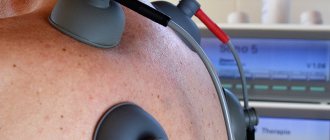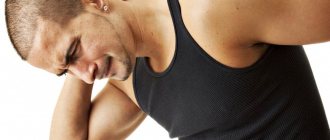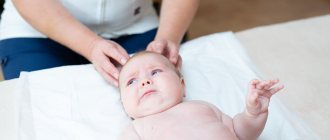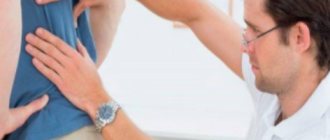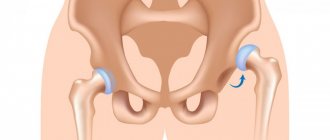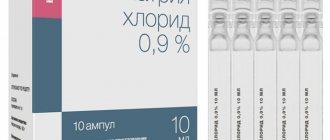Pediatric neurologist
Stepanenko
Natalya Leonidovna
31 years of experience
Neurologist, member of the Moscow Neurological Society
Make an appointment
If the spine is curved sideways along its axis, a specialist can diagnose scoliosis. It is important to make a timely diagnosis and begin treatment, because all parts of the spine are involved in this process, which will lead to twisting as the disease progresses. To make a diagnosis, the doctor conducts an external examination and prescribes a series of medical tests, the main of which is radiography.
If the doctor has diagnosed the initial degree of curvature, it is recommended to begin treatment immediately, because thoracic scoliosis is a progressive disease that over time leads to deformation of the entire spinal column, to increased physiological curvature. As the disease develops, the entire body suffers, the position of the chest and pelvis changes, and many organs fail.
The most dangerous periods are periods of intensive growth; these include age categories from 4 to 6 years and from 10 to 14 years. Experts recommend paying great attention to the time of puberty, because at this time the spine is most subject to deformation (for boys - 11 to 14 years old, for girls - 10 to 13 years old). But this is only provided that a small deviation (no more than 10˚) has already been confirmed before this period.
Parents often confuse concepts such as scoliosis and poor posture. These are two different things, scoliosis of the back is a more serious disease and do not forget that it is progressive, requiring more careful attention from both the patient (or parents, if the disease develops in a child) and the doctor. You also need to understand that poor posture can be corrected by physical exercise, but scoliosis requires a different approach.
Symptoms and signs
At the initial stage of development, the disease can be determined only by external signs; it does not show any symptoms. If parents notice that when their child stands, one shoulder is lowered, then they should immediately make an appointment with a specialist.
External signs also include the following symptoms:
- distance between waist and arm;
- asymmetrical arrangement of the blades;
- When bending forward, the curvature of the spine is noticeable.
Scoliosis can be left-sided or right-sided. Chaklin proposed a classification used in Russia. It is based on X-ray indicators and clinical signs, based on which four degrees of disease development can be distinguished:
- 1st degree scoliosis has a curvature angle of 10˚, symptoms: shoulder girdles of different heights, asymmetrical waist, stoop;
- scoliosis 2nd degree – angle of curvature from 11-25˚, symptoms: half of the pelvis is curved, a muscle roll forms in the lumbar region, protrusion in the thoracic region;
- scoliosis 3rd degree – curvature angle 26-50˚, symptoms: weakened abdominal muscles, sinking ribs, appearance of a hump and symptoms of the first two stages;
- Scoliosis 4 degrees – curvature angle from 50˚, symptoms: hump, muscle strain, severe spinal deformity.
Already at the first stage of manifestation of scoliosis symptoms, you need to contact a specialist who will choose the right treatment. JSC "Medicine" (clinic of academician Roitberg) is located in the center of Moscow: 2nd Tverskoy-Yamskaya lane, 10.
Are you experiencing symptoms of scoliosis?
Only a doctor can accurately diagnose the disease. Don't delay your consultation - call
What is scoliosis
The human spine is conventionally divided into 4 sections: cervical, thoracic, lumbar and sacral. Each of them has physiological curves: lordosis (inward bending) in the lumbar and cervical regions, as well as kyphosis (outward protrusion) in the thoracic and sacral regions.
Scoliosis is a persistent deformity of the spine in which it bends sideways in relation to the central axis. In this case, the deformation does not affect a separate part of the spinal column, but most often each of them. Scoliosis is characterized by increased natural lordosis and kyphosis. Rotation of the vertebral bodies is also observed, which provokes changes in posture of varying degrees of severity, changes in the line of the shoulders and pelvic bones.
In most cases, the main curvature occurs in the lumbar region. In this case, the rest of the ridge is also subject to compensatory deformation. Scoliosis in any form leads to disruptions in the functioning of almost all body systems, since organs are displaced from their natural positions, which, of course, affects the quality of their functioning.
Most often, scoliosis is detected in children or already in adolescence, i.e., during the periods of the most active growth of the child. Growth spurts peak at ages 4–6 and also at ages 10–14. It is these periods that are considered the most critical, so parents should not neglect preventive medical examinations of children during these time periods that are important for the proper formation of the spine.
Do not confuse poor posture with scoliosis. If in the first case we are talking about a “bad habit”, then in the second we are talking about a disease that requires qualified complex treatment.
Spinal deformity can develop in adulthood and also progress. But more often it is a consequence of the lack of timely intervention at the time of initial formation, i.e. in childhood or adolescence.
Expert Opinion of a Doctor
The earlier a scoliotic curvature is found, the easier it is to correct it with the help of exercise therapy complexes, which are often neglected by parents.
Personal: Udovenko Bogdan Viktorovich
Orthopedist, chiropractor, vertebroneurologist, osteopath
Experience: More than 20 years
Ask a Question
Causes
Thoracic scoliosis begins to develop in childhood and adolescence. The most common is idiopathic, the cause of its development cannot be determined. Among the total number of cases, this type of scoliosis accounts for 80%. Girls are mostly at risk; they are more likely to develop the disease than boys.
Also, the cause of scoliosis (20% of cases) is congenital deformity of the spine. Among the causes are diseases of connective tissues, severe injuries, amputation of limbs, different lengths of limbs.
Risk factors
There are many myths about the causes of the disease
- This is not a postural problem
- Scoliosis does not occur from a soft mattress
- Carrying heavy bags at school does not cause either curvature or progression of the deformity
- Scoliosis does not occur due to prolonged sitting in front of the TV or eating junk food
- Scoliosis is not an infectious disease - it is impossible to get infected from patients with scoliosis
A positive family history is a definite risk factor for adolescent idiopathic scoliosis. Therefore, perhaps it would be more correct to call it COI. genetic, not idiopathic. There is also an opinion that unspecified “environmental” factors play a role in the occurrence of ISP scoliosis. But the general opinion is that all the causes of scoliosis are multifactorial.
Therefore, when diagnosing COI in a teenager, it is necessary to examine his brothers and sisters from the age of 11.
When to see a doctor
It is important for parents to monitor the development and health of the child and regularly have him examined by an orthopedist. If parents notice that when their child stands with one shoulder higher than the other, they should consult a doctor. Take into account! The initial stage of development passes without symptoms, the angle of deviation is small, only a qualified specialist can notice the pathology.
Also, if a child has congenital defects, for example, different leg lengths, this may affect the development of the disease, so an appointment with a doctor is required. Timely treatment will help avoid surgical intervention. At JSC “Medicine” (academician Roitberg’s clinic) you can make an appointment with experienced doctors with extensive experience. The best traumatologists and orthopedists work here. The clinic is located at 2nd Tverskoy-Yamskaya lane 10.
Forecast
In many cases, preventive examinations in schools allow cases of scoliosis to be detected early. This allows you to prescribe the necessary treatment and conduct dynamic monitoring of scoliosis, which sometimes makes it possible to avoid surgical treatment in the future. Most people with scoliosis can live full lives. Women with scoliosis are able to become pregnant and have children without much risk of complications. But at the same time, scoliosis can be a cause of lower back pain during pregnancy.
The latest advances in the field of surgery using minimally invasive techniques and materials allow us to expect that surgical treatment will become less traumatic over time with a shorter recovery period.
Diagnostics
By contacting JSC “Medicine” (academician Roitberg’s clinic), patients will be able to undergo a full examination. Innovative equipment is presented here, doctors use modern techniques. Diagnosis of the disease takes place in several stages. The first is a physical examination. The doctor examines the patient in several positions: standing, lying, sitting. When the patient is standing, the doctor pays attention not only to the spine and asymmetry, but also measures the length of the legs, which helps to understand whether there are differences in the indicators or not.
The specialist also checks how mobile the lower back is, at what level the shoulders and shoulder blades are, and their symmetry. During the examination, the doctor examines the chest, abdomen, lower back, and pelvis. When the patient is sitting, the doctor measures the length of the spine, looks at how noticeable the curvature of the spine is from the side, and how the pelvis is located in different poses of the limbs.
While the patient is lying down, the specialist will determine the level of curvature of the spinal arch and examine the abdomen to understand how weakened the muscles are. The second stage of diagnosis is x-ray. If a doctor has diagnosed scoliosis of the spine, X-rays should be taken at least twice a year. The first x-ray is taken in a standing position, then in different positions with moderate stretching of the spine, which allows you to fully assess the situation and determine the level of deformation. After the image, the doctor will determine the angle of curvature.
The third stage is instrumental. If the disease progresses rapidly, it is impossible to frequently take x-rays, because with each image the patient receives a dose of radiation. To avoid this and obtain new information about the development of the disease, clinic specialists use ultrasound. In some cases, the patient is prescribed an MRI. The clinic practices an individual approach, the patient’s complaints are taken into account, the doctor will give advice, clarifications, and answer questions.
Preventive measures
There are no clear measures to prevent scoliosis, since sometimes the pathology manifests itself for an unknown reason.
Firstly , you should monitor your posture: injuries to the spinal discs are reduced with the habit of standing straight, sitting and walking correctly.
Secondly, an active lifestyle, in which proper muscle function occurs, is effective in preventing scoliosis.
Thirdly , it is important to remember about sleep hygiene. An elastic orthopedic mattress will help to achieve the correct position of the spine during sleep and minimize the load on it.
Treatment
The doctors of the clinic are well versed in pathology and have extensive experience; treatment of scoliosis in adults is carried out under the supervision of a qualified specialist. The doctor’s task is to determine the angle of curvature of the spine, how quickly the disease progresses, and how much internal organs are damaged. If necessary, the orthopedic traumatologist refers the patient to other specialists, for example, to a cardiologist or pulmonologist.
In order to choose a treatment method, you need to understand what caused the development of the disease, how severe it is, how it progresses, what its nature is, and what degree of the disease it is. Only after this will the doctor understand how to cure scoliosis.
Scoliosis can be treated either conservatively or surgically. Conservative methods are used if the disease was caused by an injury or shortening of a limb. By understanding and eliminating the cause, you can get rid of scoliosis. For example, the cause was different lengths of the limbs; to correct it, the doctor may suggest wearing special shoes or using special insoles. The conservative method involves special exercises for scoliosis, physical therapy, and gymnastics. At JSC “Medicine” (clinic of academician Roitberg), a set of exercises is selected individually for each patient.
If the angle of curvature is up to 15˚, then gymnastics helps correct the situation; if the angle of curvature is more than 15˚, but does not exceed 20˚, the patient is prescribed to wear a corset. The frequency and time of wearing a corset is determined individually, based on the situation, for example, it can only be at night, or it can be both night and day. The duration (six months or more) is also determined individually.
If the angle of curvature is within 20-40˚, the patient is admitted to the hospital.
If conservative methods do not stop the progression of the disease, and the angle of curvature reaches 45˚, surgical intervention is prescribed. During the operation, the spine is aligned to a certain angle and fixed using special metal structures.
Kinds
It is already clear that scoliosis in children can be congenital or acquired. For a more detailed description of the pathology, a more precise classification of the forms of the disease is used based on the period of its occurrence:
- infantile (baby) – found in children under 3 years of age;
- juvenile – develops at 3-10 years;
- teenage - occurs during puberty, i.e. at 10-17 years.
All these forms of the disease respond well to treatment, which cannot be said about adult scoliosis. Therefore, it is very important to diagnose the pathology in time and direct the maximum amount of effort to eliminate it before it is too late.
With adult scoliosis, diagnosed in people over 17 years of age, especially advanced scoliosis, it is almost impossible to achieve absolute recovery even with the help of surgical intervention.
The following types of scoliosis in children are also distinguished depending on the nature of the curvature:
- C-shaped - the spine is curved to the left or right side with the formation of 1 arch;
- S-shaped – 2 multidirectional scoliotic curves are simultaneously formed in two different parts of the spine, for example, in the lumbosacral and thoracic;
- Z-shaped is the most severe form of scoliosis, in which 3 scoliotic arches are formed at once.
Consequences of the disease
If scoliosis is left unattended, the disease will progress. In the early stages, serious consequences are not noticeable. However, as the pathology progresses, deformation of the chest occurs. Severe pain occurs in the deformed part of the spine during physical activity and prolonged static position. The ribs begin to shift, putting pressure on the chest and heart muscle. The first signal will be difficulty breathing and a change in heart rate. Patients often experience pathologies of the pelvic organs, gastrointestinal diseases, stool and urination disorders.
Among the most likely consequences:
- pinched nerves,
- displacement of internal organs and tissues,
- metabolic disorder,
- diseases of various organs and systems.
